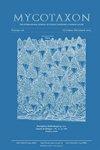中国文山山藻(Callosus wenshanensis gen.&sp.nov.)
IF 0.4
4区 生物学
Q4 MYCOLOGY
引用次数: 0
摘要
根据形态和分子特征,本文提出了一个新的类皮质木栖真菌属Callosus,以文山C.wenshanensis为代表。该种的特征是具有光滑、奶油色处女膜表面的重孢子担子体,具有带有单隔膜的生殖菌丝的单体菌丝系统,以及椭球、透明、薄壁和光滑的担孢子(2.3-3.9×1.4-2.3μm)。使用最大似然、最大简约和贝叶斯推理方法分析nrDNA内部转录间隔区(ITS)和大亚基(28s)序列。系统发育分析支持Callosus在一个与原毛平革菌和根毛菌密切相关的单系谱系中。本文章由计算机程序翻译,如有差异,请以英文原文为准。
Callosus wenshanensis gen. & sp. nov. from China
A new genus of corticoid wood-inhabiting fungus, Callosus, typified by C. wenshanensis, is proposed here based on morphological and molecular characters. The species is characterized by resupinate basidiomata with smooth, cream-colored hymenial surfaces, a monomitic hyphal
system with generative hyphae bearing simple septa, and basidiospores (2.3–3.9 × 1.4–2.3 μm) that are ellipsoid, hyaline, thin-walled, and smooth. The nrDNA internal transcribed spacer (ITS) and large subunit (28s) sequences were analyzed using maximum likelihood, maximum
parsimony, and Bayesian inference methods. Phylogenetic analysis supported Callosus in a monophyletic lineage closely related to Phanerochaete and Rhizochaete.
求助全文
通过发布文献求助,成功后即可免费获取论文全文。
去求助
来源期刊

Mycotaxon
生物-真菌学
CiteScore
1.20
自引率
10.00%
发文量
53
审稿时长
3 months
期刊介绍:
Mycotaxon is a quarterly peer-reviewed journal exclusively devoted to all phases of the taxonomy and nomenclature of fungi (including lichens). All articles are peer-reviewed by specialists prior to acceptance. Publication is open to all persons. Authors prepare their own article after having received critical comments from pre-submission reviewers .The journal is published with one volume each quarter. Articles are accepted in English only, with summaries or abstract in any language(s).
 求助内容:
求助内容: 应助结果提醒方式:
应助结果提醒方式:


